Lenovo ThinkVision P27h Monitor Review
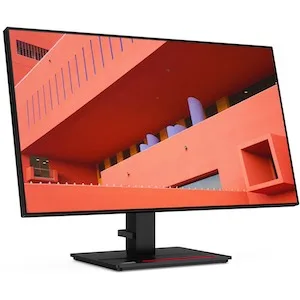
Summary
Quick verdict: Great performance from the feature-rich Lenovo ThinkVision P27h makes it a winner for professionals wanting to dock their laptop to a monitor.
- Bright, sharp, colour-rich screen
- USB-C and USB-A charging works a treat
- Adjustable stand
- Well-priced
- Speaker is terrible
- Ports are hard to reach
- Base is a little awkward
- Setting adjustments have minimal effect
The Lenovo ThinkVision P27h monitor offers great bang for your buck. While perfectly functional for gaming and general use, it's a great fit for professionals, thanks to its excellent colour accuracy, large screen real estate and 1440p IPS screen. It's particularly well-suited to owners of USB-C laptops, such as the MacBook, who are looking for a docking and/or second screen solution.
This is largely thanks to the powered USB-C port, which enables you to easily connect and power your laptop to the monitor.
And coming in at around $600 (as of the time of writing), it's well-priced for a USB Type-C charging monitor. Especially as it doesn't shirk other great features that you'd normally expect to see in pricier models. The 2020 model also improves key elements of early models, with faster charging, a better USB-C cable and a speaker.
Read More: The best computer monitors of 2021
Features
Features
- USB Type-C powered port
- 99% sRGB colour accuracy
- Stand is highly adjustable
- Contrast ratio is weak
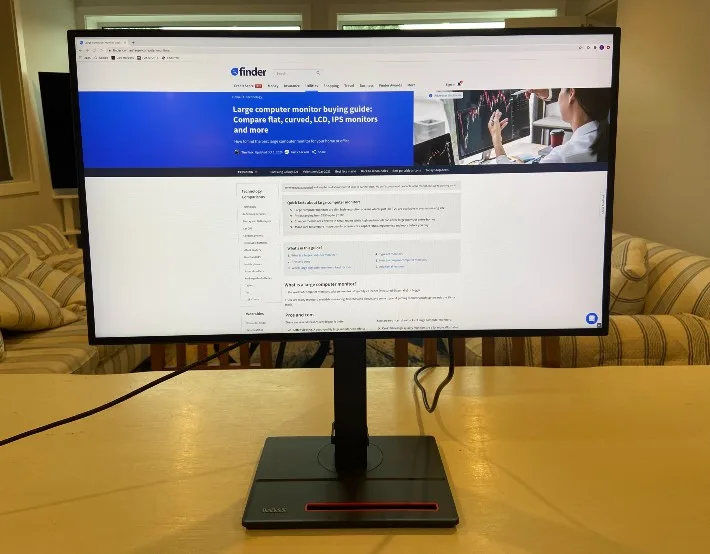
The Lenovo ThinkVision P27h monitor comes with heaps of great features. You can expect to find two display ports – an in and an out, the latter allowing you to daisy chain monitors together. There's also one HDMI 1.4 port, an audio jack, one USB-C port and four USB-A ports. The HDMI port is outdated, which may cause a bit of grief if you intend to hook up a video game console to the monitor.
The USB-C port and one of the USB-A ports are powered, meaning that you can charge as well as use the connected device. More power comes through the Type-C port than in older models, with a 65W base level. However, you can enter two super-powering modes that deliver 85W or 90W. The latter does reduce screen brightness and USB functionality.
Speaking of brightness, the Lenovo ThinkVision P27h provides an admirable 350 cd/m2. In fact, the IPS screen really impresses. The 4ms response time is good enough to make it double as an okay gaming monitor, even if the 60Hz refresh rate isn't as conducive to online fragging.
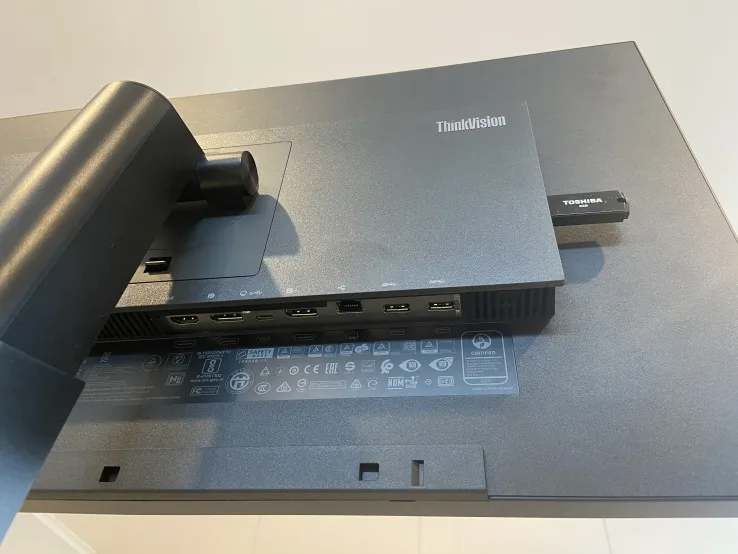
The 2560x1440 (QHD 1440p resolution) hits that sweet spot for professional users that ensures most programs won't suffer from any of the scaling issues we sometimes see with 4K monitors. The 99% sRGB accuracy, a hallmark of IPS screens, is great and it's easy to see what's going on from wide angles. The 1000:1 contrast ration isn't spectacular though and is a potential weakness.
The stand can be swivelled 360 degrees or height adjusted with ease. The entire panel can also be turned vertical and I appreciate that it has a standard VESA wall mounting option, too.
The marketing material for the Lenovo ThinkVision P27h refers to a "Near Edgeless" screen. This is an interesting – and subjective – wording choice that I don't think works in the monitor's favour. We have mobile phones and TVs now that have screens that go right to the edge. While the Lenovo ThinkVision P27h does have a subtle frame, there's a good 10mm black bar in the screen's border.
This may irk some users who are expecting maximum screen real estate from the frame, but personally, I think it makes little difference on a 27-inch monitor. I suspect most users wouldn't even notice until it was pointed out to them.
The monitor comes with a USB-C to USB-C cable. Reviews of previous ThinkVision P27 models speak to these cables being unreliable or not working at all. I suspect this has been rectified in the 2020 model. I can confirm that my cable worked instantly and without issues.
Design
Design
- Stand is easy to adjust
- Menu buttons are outdated
- Ports are hard to access
- Bulky base
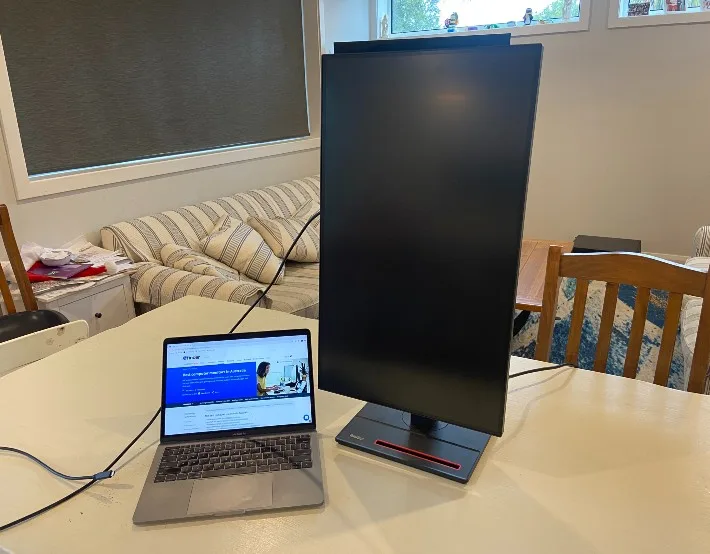
When you've seen one monitor, you've seen them all, right? It can feel that way when you're scrolling through websites looking for monitors. But there are subtle differences to their design that can impact your purchasing decision.
The Lenovo ThinkVision P27h is a flat screen panel, not curved. At 27 inches, the flat screen works fine. It's only when you start pushing into to the 30-inch range that the curved monitors really start to come into their own. It's not touchscreen-enabled, either.
An easily reachable clip at the back of the monitor allows you to pivot it from horizontal to vertical. Adjusting the height, tilting the screen and swivelling it only requires a firm hand movement. I experienced no issues with the screen falling or wobbling untowardly during use.
The base plate has an interesting design. It's a bit blocky as a largish rectangle. If you've come from using a monitor with an arc stand, such as with LG and Samsung, this blocky base may feel like it encroaches into your workspace too much. However, it does have a slot in the top of it that holds your mobile phone up vertically. So that could very well prove to be a multitasking feature you'll appreciate, nullifying the issue of its blocky design.
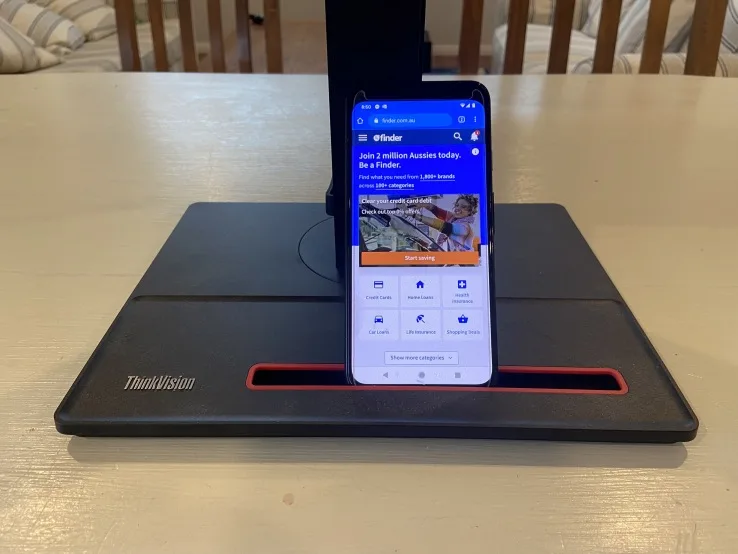
As for the vast selection of ports, the impressive quantity is somewhat let down by their accessibility. None of the ports are near the edge of the screen and they are instead more centrally located on the back. Basically, you're not going to be able to easily put them in and out while sitting. You'll need to swivel the monitor or stand up.
Given that this is a monitor that separates itself by its ability to charge devices as well as connect laptops with ease, this feels like a misstep. The USB-C and at least the charging USB-A port should be at the edge of the screen in my opinion.
Performance
Performance
- Screen is sharp and bright
- Super charge mode
- Picks up laptop instantly
- Settings tweaks have little impact
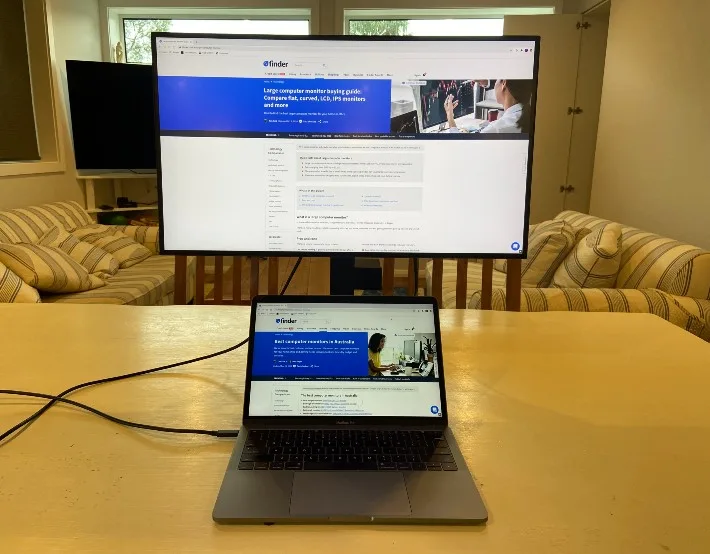
I tested the Lenovo ThinkVision P27h monitor alongside a 2017 Macbook. Within 30 seconds of connecting the USB-C cable between the two, I was using the ThinkVision as a second screen. I didn't have to actively do anything, I just dragged a window across to the new monitor and began experiencing my content in 27 inches of 1440p glory. The ease of use is spectacular in this regard.
Likewise, my MacBook started charging immediately, accepting 65W of juice. Within half an hour, my battery was up 30%. The fact that there are two additional charging tiers – an 85W and a 90W, the latter reducing brightness and USB functionality – is excellent. You can quick-charge your phone, for example, before you go out.
I was also immediately impressed by the clarity and sharpness of the screen. Dragging a window out of my MacBook and onto the ThinkVision was like stepping from the dark side of the moon into the light. It really popped. Plus, at 27 inches, it's big enough to split into two windows for further multitasking.
The menu is clear and obvious to follow, even if the buttons are a little tedious to operate. However, there isn't a great impact when altering settings such as brightness or contrast. Users who like to operate on the extremes of these meters may find the ThinkVision doesn't meet their needs. It wasn't an issue for me and there are some handy presets to select from for those looking for quick-fix selections.
The monitor is let down by its speaker. While it's handy that a speaker has been introduced, the sound quality is poor and the placement of the speakers at the centre-back of the monitor only makes that performance worse. There is a headphone jack and Lenovo does sell a cheap $28 USB soundbar accessory. But maybe the latter should have just been included in lieu of a speaker.
Should you buy the Lenovo ThinkVision P27h monitor?
- Buy it if you're looking for a feature-filled USB Type-C monitor that can charge your laptop.
- Don't buy it if your primary focus is gaming, or you need a small stand footprint.
The Lenovo ThinkVision P27h impresses. It's not without some notable design flaws, but for sheer performance, it's great value for money. Especially because it's so feature-rich. It backs up a great screen experience with plenty of flexibility. Adjustable, capable of charging via USB-C or USB-A and offering a range of additional ports, it ticks plenty of boxes for the modern-day professional.
If you want to be able to come home, plug your laptop straight into your monitor and continue with minimal fuss, consider the Lenovo ThinkVision P27h.
Pricing and availability
At the time of writing, Lenovo has a deal on its website where you can get $40 off the ThinkVision P27h monitor. If you don't need to daisy chain monitors – so you don't need the "out" Display Port – you can save a few more dollars by getting the ThinkVision T27h monitor. Just make sure that you don't opt for the ThinkVision P27q or T27q, as they don't feature USB Type-C.
Specifications
Specs
Features
Images: Chris Stead
More Finder reviews
- Apple HomePod 2nd Gen review: Yes, it’s better
- Creality Ender-3 S1 Pro Review: Plenty of creative potential, but you’ll need patience too
- Apple Mac Mini M2 Pro review: A tale of two computers
- Apple MacBook Pro M2 Max 16-inch review: Next-level power
- HTC Vive XR Elite: Is this the perfect mix of Flow and Pro?

